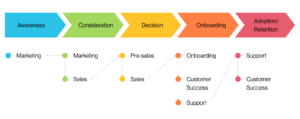…identify the main pillars and harmonise them for the mutual good (2)
As is the case with any change management process, the building blocks required in the journey to the ‘Promised Land’ must be clear and concise. The execution process must be preceded by careful steps to identify why the initiative is necessary, what has to be done to achieve the defined goals, who has to do what to ensure that activities within the process are executed to the right specifications and a tangible process for ensuring that the outcomes reflect stakeholder aspirations of how success should look like.
In the last article, we identified four of these building blocks as: leadership in facilitating and delivering CX and embedding it in our internal processes as second nature; developing a CX culture where what we do and how we think resonate and align with customer sentiments; facilitating the change management to address what needs changing to keep aligned; and an audit process to ensure that we are focused. Having a well-defined process for evaluating and anticipating our customers’ sentiments as they journey across our touchpoints is critical.
Leadership will define the vision and drive the process through a balanced application of methods and means to keep everyone aligned to the singular purpose of delivering out-of-world experiences to customers. When the culture is customer-friendly, everyone is determined to do a little more to ensure that the customer goes away satisfied with the way her issue was addressed. Leadership lives culture and through their actions, behaviour and emotional intelligence, coupled with superior thinking and actions, they lead the process.
When Michael Gerber stepped into a hotel the first time, his goal was to find for himself a place of temporary sojourn with reasonable comfort during an official trip upstate. He noticed something rare after a few more visits to this particular hotel and that got him interested enough to even mention it in his book, the Entrepreneurial Myth. When we are deliberate about how we engage and serve customers, they notice it and they respond by becoming loyal to our brand. This means the customer experience is not a one-off event, but a continuous process with consistent attention to detail and a deliberate effort to replicate successful outcomes.
Jeff Sheehan shares four more distinct pillars that will consolidate the relationships we cultivate with our customers to keep them aligned. These include: journey mapping operations to keep the customer journey in focus and to work persistently to ensure that our customers enjoy happy landings or great experiences as opposed to turbulence or poor experiences; CX governance to keep the organisation aligned to its core mandate of achieving favourable financial results; effective CX metrics and well-preserved brand reputation while delivering excellent experiences.
The others are a CX strategic plan that synchronises seamlessly with the business strategy one that ensures a clear top-down direction with sufficient bottom-up specific cx-driven initiatives, underpinning the organisation’s overarching strategy and poised to deliver the promises made by the brand strategy. Lastly, customer understanding is where our focus is on ensuring that there is no ‘radio-silence’ in how we engage and address our customer’s needs. This includes the development of a Voice of Customer Programme which works relentlessly to distill customer feedback to learn what customers love or loathe and why.
The customer journey
The customer journey, according to Alan Pennington (2018), is “a structured way to understand and capture your customers’ wants, needs and expectations at each stage of their experience with your company”. It means understanding very clearly our customers’ interactions with us from their viewpoint. We do this by capturing individual interactions with customers from initial awareness to the point where they leave and, perhaps, return. With an intuitive understanding of this process, a business can potentially enhance the experience of the customer to gain market leverage and business growth.
We use journey maps to give us a visual expression of our current processes. By capturing the steps in the customers’ journey while they are interacting with us, we can assess the as-is state of the process and envision what the future could be. Note that the journey maps are not the deliverables, they are the research tools to enhance our understanding of our processes and how these serve the customer. It allows us to understand, for example, our ordering process, the state of our technology, compliance, and how effectively our functions support customer interactions.
The Customer Journey

The journey in the image is split into five stages referred to as touchpoints, illustrating how the customer thinks, feels and acts along the entire customer lifecycle. This will help in knowing and segmenting customer behaviour based on the different stages highlighted. It helps us focus and address specific opportunities and roadblocks along the buyers’ journey. The touchpoints are as follows:
Awareness at which stage the customer is exploring your company – through an ad, inquiry, tweet or referral by a friend.
Next is a consideration where the customer recognises the need for the product, and actively researches as she seeks a suitable solution. The decision stage is where the customer has thoroughly assessed options, looked up reviews, checked on pricing and policies, etc., and is ready to purchase to meet their need. The internal effort will be aimed at marketing and pre-sales activities. Next is where the customer – Onboarding – reevaluates to either buy or move on. It depicts the net retention, the rate at which customers are choosing to continue their commitment to our brand or otherwise.
Finally, we have advocacy –Adoption and Retention – where a satisfied customer is happy to come back and also refer us to friends and colleagues. Think of how many times we have bought something in which we were influenced by a friend’s opinion or suggestion. There are a plethora of models that explain the customer journey. Adapt what works best in your context.
CX governance
The process of soliciting, responding and acting on feedback obtained from customers – deliberately managing all things relating to the experience customers are having with our brand. Developing governance around your customer experience requires attention to detail and an avowed commitment to standards. According to CXPA, the professional organisation for CX professionals, governance must have a structured approach to addressing the aims of your CX agenda. It recommends the following requirements to bring this to fruition. A governance system will offer you the following:
- Enables a sustainable CX programme by establishing a recurring set of actions and activities that incorporate CX into the standard operating procedures of the company
- Shares and reinforces common CX standards and behaviours that are aligned with the enterprise CX vision and strategy
- Puts the controls and criteria in place for prioritising CX-related initiatives across all functions of the company that will improve both customer and company outcomes
- Ensures the proper measurement indicators and review processes are in place to drive accountability and execution of initiatives that will result in continuous, implemental CX progress
A good governance system, according to CX expert Jeff Sheehan, will enable you to perform the following creditably:
First, sponsorship, where a senior member – notably the CEO – commits to the CX programme through the improvement of cross-functional collaboration and the formalisation of the organisation’s customer experience management goals. Secondly, a CX strategic plan that articulates the intended purpose and the expected outcomes of the organisation’s CX programme. Customer understanding, where a Voice of the Customer Programme exists to facilitate effective listening to customer issues.
Additionally, a CX operations process that includes feedback elicitation and CX metrics reporting with dotted line compliance across all internal functions. An investment plan to address CX investments on an ad hoc basis for continuous procurement of CX tools is also needed to ensure that the governance team is well-resourced to manage key activities, such as internal research with stakeholders, selecting and procuring tools such as feedback management platforms, third party customer research, or management consulting services.
Two other areas highlighted here are the culture and organisations encompassing the people aspect of organisational change management. This is where the CX leadership collaborates with HR to address people issues in the CX context. Finally, there is the job of CX impact where you define metrics and the benchmark for those metrics in the organisation. It can also include internal and external assessments. It helps assess your programme’s effectiveness against realistic benchmarks.
CX strategic plan
The business strategy and the brand promise are the two bed-fellows on which the CX programme runs. Having a CX strategy will provide you with consistency in the delivery of both elements. For example, when your strategy declares that as an organisation you are customer-centric, the strategic plan articulates how you will use feedback and customer research to inform core activities, such as new product development and research.
These days, with digital transformation, customers are better informed; and this has raised expectations higher. Today’s business must, therefore, prioritise investments in technology as a key differentiator to win customers. According to a Walker study, “Customer Experience will overtake price and product as the key brand differentiator in coming years”. A sound digital experience strategy encompasses all business functions in what experts refer to as ‘omnichannel’.
Omnichannel is a multichannel approach to sales that provides customers with a seamless shopping experience regardless of the channel. In other words, whether they are shopping online or from a desktop or mobile device, telephone or physical store – brick-and-mortar, the experiences are comparable. For example, a known brand might sell its products on its website, app or social media channel and Amazon as well as ‘brick-and-mortar’.
To sum it up, the CX strategy synchronises with the organisation’s business strategy in the following ways: While the business strategy encapsulates the mission, values and business goals, the brand strategy delivers the personality of the business and its promises to customers. A CX plan aligns with the two by delivering the organisation’s channels and touchpoints as an enabler of business goals and brand promises.
Customer understanding
An important quote on listening is worth mentioning: “Listen, at least, as much as you talk”. A former CEO of Chrysler, Lee Iacocca, uttered the following: “I only wish I could find an institute that teaches people how to listen. Business people need to listen, at least, as much as they need to talk. Too many people fail to realise that real communication goes in both directions”. As businesses, we must learn to listen as much as we talk. Remember, in CX terms, not listening is referred to as ‘navel-gazing’. You learn when you listen, you improve when acting accordingly.
To keep up with customer expectations in our contemporary world, we must invest in Voice of the Customer (VoC) programmes that employ a closed-loop process. This requires that we capture accurately what customers are saying about our business, product or service. It includes customers’ feedback about their experiences with and expectations for our products or services. It requires a focus on customer needs, expectations and understandings to enable us to undertake product improvements.
By capturing data from our customer interactions, we are better poised to improve how a customer experiences all interactions with the business. VOC is best understood using technology, such as text analytics and sentiment analysis, to ensure that we can find meaning in the customer feedback data. The cycle here involves a process of listening, learning and acting on the insights to improve product and service delivery ‘outside-in’.
These elements present the building blocks for a holistic customer experience management regime – a key differentiator for any business. A CX management process encapsulates the following major elements: leadership, culture, change management, audit, governance, strategy, journey mapping, and customer understanding. Get these under your belt and you are good to go with your CX programme.
The Writer is a Change and CX Management Consultant. He can be reached at 059 175 7205, [email protected],
https://www.linkedin.com/km-13b85717










